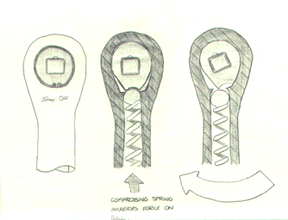
| MadSci Network: Engineering |
Joe,
This was a tough question. None of my engineering books showed any representations of a torque wrench's internal mechanisms, and neither did any of the more prominent tool manufacturer's websites.
I have drawn up a design that demonstrates the concept of how (I understand) a torque wrench slips when you meet/exceed the torque setting of the wrench, however I'm not expecting any tool manufacturers to be contacting me for my services based on this design ;) .

A click type torque wrench is designed to slip or "give" when a set torque level is met or exceeded, physically signaling the user that the bolt or nut is tight enough. The first representation shows the head of my torque wrench where the 3/8" drive fitting for the sockets etc. is facing us. The next two drawings show cutaway views that show a ball bearing, a spring, and a part of the wrench inside the wrench head that can freely rotate inside the wrench head through a limited range of travel (we'll call it a cam for lack of a better term) and connects directly to the socket which attaches directly to the bolt/nut head.
By adjusting a dial on the bottom of the wrench the tension in the spring can be increased by mechanically compressing the spring. In the above design the spring then applies force to the ball which applies a resistance to the rotation of the cam where the socket attaches. The more one compresses the spring the greater the resistance is applied by the ball. When the torque applied exceeds the amount of pressure exerted by the ball to resist motion (simplified explanation), the ball is pushed down and the wrench slips until the cam strikes the inner wall of the wrench itself and stops the slipping motion. When the operator applies a force to the wrench and the ball is pushed down against the spring the wrench will "slip" slightly and the user will know that the torque setting has been exceeded.
I would recommend two paths to see the actual designs of torque wrenches. The first is to see the US Patent Office website at http://www.uspto.gov/patft/
and search on a given manufacturer's name and "torque wrench". This would be easier I think if you know an actual patent number in use by the manufacturer and view that patent application. The applications usually show the designers concept in drawings. The second option would be to send your request to a tool manufacturer and ask them to supply you with a drawing for educational purposes. I think Snap On tools (email them at questions@snapon.com) would be a good place to start and their customer service has always been very accommodating, but most manufacturers should be helpful.
I think that my images depict the general idea of how a click type torque wrench slips but I am sure there are many better and more elaborate designs. I hope I have accurately conveyed the concept, anyway. One thing with these types of wrenches that is very important is that after use it should be stored with all the tension removed from the spring (torque setting on dial set to "0"). If you store the wrench with the spring under tension the spring length/rate will change and the wrench will no longer be accurately calibrated.
Sincerely,
Steven Miller
Undergrad - Mechanical Engineering
San Diego State University
Try the links in the MadSci Library for more information on Engineering.